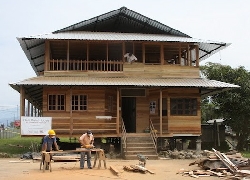
Ecuador Jungle Home Dedication Oct. 30
SHELL, Ecuador, Oct. 4 /
Christian Newswire/ -- The loving four-month restoration of the house that MAF (Mission Aviation Fellowship) missionary Nate Saint built on the edge of the jungle in 1948 is nearly complete. Hundreds from Ecuador and abroad are expected to attend the ceremony to dedicate the historic building at 3 p.m. Oct. 30.
Photo (click for hi-resolution version): Arizona volunteers formed a short-term work team that helped restore the Shell, Ecuador, home of MAF (Mission Aviation Fellowship) pilot Nate Saint, who was martyred with four other missionaries in 1956. Historic restoration of the house, built in 1948 by Saint and a missionary team, is nearly complete. The house will be dedicated Oct. 30. Additional photos available online.
"Nate Saint and a team of missionaries helped build this house for Nate's family, facilitating the pioneering outreach that eight years later led to his martyrdom," said John Boyd, MAF president. "Its restoration means that his home will continue to be a center of ministry and witness of Christ's hope for generations to come."
The dedication will include sharing the Nate Saint story, a presentation of the gospel and a prayer of dedication. It will be conducted in English, Spanish and Waorani, the language of the people group that the five missionaries were visiting when tribal warriors killed them on Jan. 8, 1956.
Chris Nevins, president of Fuel the Mission, the nonprofit construction ministry that restored the home, said that a core crew of eight Ecuadorian workers with two short-term work crews from the United States have labored 90 construction days. Since June 15 when work began, 350 college and high school students and families from Europe and the United States have visited the house.
"We are grateful to God for Fuel the Mission and the many ministry partners who have given their time and other resources to the restoration project," said Boyd.
Visitors during the restoration included Mincaye Enquedi, 75, one of the last three survivors of the Waorani warriors who martyred the missionaries. Mincaye, who speared Saint, became a Christian. Today he serves as a church elder while his grandson is associate pastor of an Ecuadorian church that some MAF families attend.
Nate Saint's son Steve visited in August, and retired missionary Frank Drown, 89, who helped build the house, stopped by with his wife, Marie. Drown broke the news of the men's martyrdoms to their wives in the kitchen, a scene documented in a famous Life magazine spread. Drown helped recover the bodies and bury his friends in a driving rainstorm. Drown family members Richard, Roger and Joelle helped with the renovation this summer.
Flying termites had nearly eaten the whole house. Without intervention, Nevins estimates that the structure would have collapsed within a year. The foundation, all but one foundation pier, the radio room, all doors, first-floor beams and 20 percent of the lumber are original in the renovated house. The kitchen will look mostly as it did in 1956. Some rebar remaining from construction of a trailer roof for Rachel Saint, Nate's sister, was also used in the reconstruction.
Nevins, of Scottsdale, Ariz., founded Fuel the Mission to help mission groups worldwide with their construction needs. His team is raising the $75,000 needed to complete the restoration.
Founded in the U.S. in 1945, MAF (www.MAF.org) missionary teams of aviation, communications, technology and education specialists overcome barriers in remote areas, transform lives and build God's Kingdom by enabling the work of more than 1,000 partner organizations. With its fleet of 58 bush aircraft, MAF serves in 42 countries. MAF pilots transport missionaries, medical personnel, medicines and relief supplies, as well as conduct thousands of emergency medical evacuations in remote areas. MAF also provides telecommunications services, such as satellite Internet access, high-frequency radios, electronic mail and other wireless systems.

